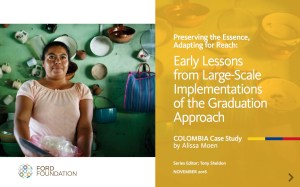The Challenge
According to 2014 data from the World Bank, about a third of Colombia’s population lives in poverty. Four million people, primarily in the country’s rural areas, are considered extremely poor, meaning that they are unable to meet their basic daily needs. Afro-Colombian and indigenous communities, which have historically been marginalized, suffer disproportionately from systemic poverty. Further, Colombia’s long-running internal conflict displaced and impacted seven million people. In response to persistent income inequality, including a widening poverty gap between urban and rural populations, the Colombian government began investing in programs to provide support to vulnerable households, particularly those living in extreme poverty and/or displaced by the civil conflict.
What We Did
Colombia was one of the eight countries included in the first efforts by the Ford Foundation and the Consultative Group to Assist the Poor (CGAP) to adapt and test the Graduation Approach. Between January 2013 and December 2014, Colombia’s Department for Social Prosperity (or DPS, for its Spanish name, Departamento para la Prosperidad Social) invested in a pilot initiative aimed at improving the productive, financial, human and social capital of Colombia’s rural extreme poor. The initiative, called Produciendo por Mi Futuro (Producing for My Future), was implemented by DPS in partnership with Fundación Capital, a non-governmental organization focused on economic development, with additional support from the Ford Foundation. Producing for My Future was implemented in San Luis, located in the inland department of Tolima, and Sitionuevo, in the Magdalena department on the northern coast, with a total of approximately 1,000 families over a two-year pilot period. The pilot tested adaptations to the Graduation Approach, intentionally leveraging existing government social protection programs by integrating them into the Approach. In 2015 and 2016, DPS began working in three new locations (Atlántico, Nariño and Sucre) with the aim to reach 10,000 participants living in extreme poverty. The program aimed to reach 35,000 participants in sites across six locations (to be determined) across Colombia by 2018.
What We Learned
“As one program manager emphasized, Producing for My Future may not necessarily pull families fully out of extreme poverty; rather, the real impact of the program is that it marks the first step to move a family forward along the spectrum of sustainable livelihoods.”
The case study examines each phase of the initial project, and explores how changes in methodology and government-led implementation affected the program. It also provides lessons learned and reviews additional changes that will be implemented as the Colombian government continues to expand the program in new regions across the country.
Initial evaluations indicated the Producing for My Future pilot made a positive impact on the lives of the majority of the participants. About half reported an increase in income, the percentage of participants saving increased dramatically, and self-reported levels of confidence and self-esteem of participants improved. Nearly 20 percent of participants who completed the program reinvested their earnings to expand their initial business or start a new project.
Some key lessons learned from the pilot’s implementation are:
- Selecting participants from an up-to-date government database is effective and cost-efficient. When project implementers did a cross-referencing exercise to compare participant selection of the government database versus the participatory mapping, they found the two approaches yielded comparable results—both methods identified families of similar poverty levels as potential participants. This was an important learning because the participatory mapping option is significantly more costly and more time- and labor intensive.
- Leverage other consumption support programs if possible. Leveraging existing consumption support programs is a cost-efficient way to integrate new initiatives without duplicating efforts and resources.
- Promote individual and groups savings strategies. Basic savings training is valuable for extremely poor and vulnerable populations. Establishing the discipline of setting aside money for emergencies and other long-term goals provides important security for participants.
- Increase the asset transfer amount for livelihood and economic development activities. The total amount of the asset transfer cash disbursement—approximately USD 500—was often insufficient to help pull families out of extreme poverty.
- Increase technical assistance to participants. One shortcoming identified during the pilot was the unmet demand for specific technical assistance during business development, launch, and ongoing operations. This includes specific agricultural support to ensure participants understand how to grow healthy crops, veterinary support for families raising chickens or pigs, and more consistent support across the course of the project.
- In-person coaching sessions are critical to the participants’ success. The bi-monthly visits were key to strengthening the self-esteem, confidence, and motivation of the participants. Having the consistent attention and reliable follow-up helped ensure that participants stayed on track and motivated with their business plans.
- Create a follow-up monitoring plan. In addition to a robust monitoring system throughout the implementation of the program, all stakeholders identified the need for a follow-up plan after the participants graduate from the program.
